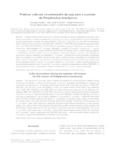Use este identificador para citar ou linkar para este item:
http://www.alice.cnptia.embrapa.br/alice/handle/doc/1058265| Título: | Práticas culturais na entressafra da soja para o controle de Pratylenchus brachyurus. |
| Autoria: | DEBIASI, H.  FRANCHINI, J. C.   DIAS, W. P.   RAMOS JUNIOR, E. U.   BALBINOT JUNIOR, A. A.   |
| Afiliação: | HENRIQUE DEBIASI, CNPSO; JULIO CEZAR FRANCHINI DOS SANTOS, CNPSO; WALDIR PEREIRA DIAS, CNPSO; EDISON ULISSES RAMOS JUNIOR, CNPSO; ALVADI ANTONIO BALBINOT JUNIOR, CNPSO. |
| Ano de publicação: | 2016 |
| Referência: | Pesquisa Agropecuária Brasileira, Brasília, DF, v. 51, n. 10, p. 1720-1728, out. 2016. |
| Conteúdo: | RESUMO: O objetivo deste trabalho foi avaliar o potencial de práticas culturais, adotadas na entressafra, para reduzir a população e os danos causados por Pratylenchus brachyurus em soja. Realizou-se um experimento em área naturalmente infestada, nas safras 2010/2011, 2011/2012 e 2012/2013, em Vera, MT. Os tratamentos foram: milheto (Pennisetum glaucum) 'ADR 7010' (2010/2011) e 'ADR 300' (nas entressafras seguintes); milho (Zea mays) 'BRS 1010' (2010/2011) e 'GNZ 2005' (nas entressafras seguintes); braquiária ruziziensis ( Urochloa ruziziensis); capim -marandu (U. brizantha 'Marandu'); crotalária (Crotalaria ochroleuca); C. juncea; C. spectabilis; C. spectabilis + milheto 'ADR 300' (de 2011/2012 em diante); alqueive mecânico (duas gradagens + herbicida); pousio (sem controle de ervas daninhas); e testemunha (alqueive químico, com aplicação de herbicida). O alqueive mecânico, as crotalárias e C. spectabilis + milheto reduziram a população do nematoide antes da semeadura e nos estádios iniciais da soja. Após a colheita da soja, a população de nematoides não diferiu entre os tratamentos, o que indica que a multiplicação destes na cultura foi maior nos manejos com menor população inicial. O uso de C. spectabilis, milheto e C. spectabilis + milheto contribuíram para as maiores produtividades de soja. O cultivo de C. spectabilis , solteira ou consorciada ao milheto 'ADR 300', é a melhor opção para reduzir a população e os danos causados por P. brachyurus à soja na entressafra. ABSTRACT: The objective of this work was to evaluate the potential of cultural practices, adopted during the soybean off-season, to reduce the Pratylenchus brachyurus population and damages to soybean. An experiment was carried out in a naturally?infested agricultural field, in the growing seasons of 2010/2011, 2011/2012, and 2012/2013, in the municipality of Vera, in the state of Mato Grosso, Brazil. The treatments were: 'ADR 7010' (2010/2011) and 'ADR 300' pearl millet (Pennisetum glaucum) (in the following off- seasons); 'BRS 1010' (2010/2011) and 'GNZ 2005' corn (Zea mays) (in the following off-seasons); Congo grass (Urochloa ruziziensis); 'Marandu' palisade grass (U. brizantha 'Marandu'); slender leaf rattlebox (Crotalaria ochroleuca); sunn hemp (C. juncea); showy rattlebox (C. spectabilis); C. spectabilis + 'ADR 300' pearl millet (from 2011/2012 onwards); fallow (weed control by two diskings + herbicide); fallow (without weed control); and control (fallow with weed control by herbicide). Fallow (two diskings + herbicide), rattlebox species, and C. spectabilis + pearl millet reduced the nematode population before planting and during the early soybean stages. After soybean harvest, the nematode population did not differ among treatments, which indicates that the nematode multiplication on the crop was higher in treatments with lower initial population. The use of C. spectabilis , pearl millet, and C. spectabilis + pearl millet favored higher soybean yields. The cultivation of C. spectabilis – alone or associated with 'ADR 300' pearl millet – is the best suitable option to reduce the P. brachyurus population and damages to soybean in the off-season. |
| Thesagro: | Soja Sistema de cultivo Pousio Prática cultural Nematóide Planta de cobertura Pratylenchus Brachyurus |
| NAL Thesaurus: | Soybeans Fallow Plant cultural practices Nematoda Cover crops |
| Palavras-chave: | Pratylenchus bachyurus |
| Tipo do material: | Artigo de periódico |
| Acesso: | openAccess |
| Aparece nas coleções: | Artigo em periódico indexado (CNPSO)  |
Arquivos associados a este item:
| Arquivo | Descrição | Tamanho | Formato | |
|---|---|---|---|---|
| 232771155131PB.pdf | 425,57 kB | Adobe PDF |  Visualizar/Abrir |









